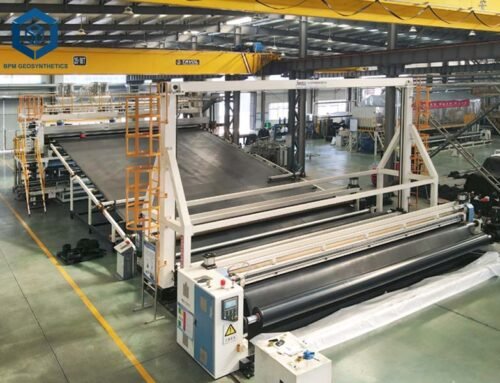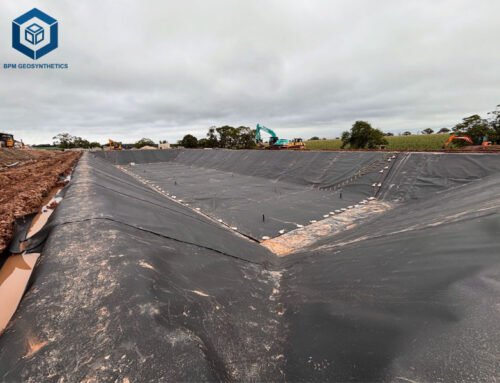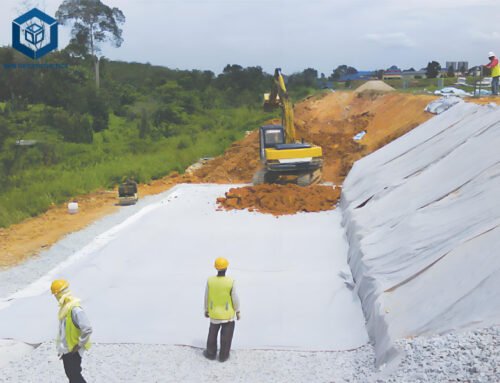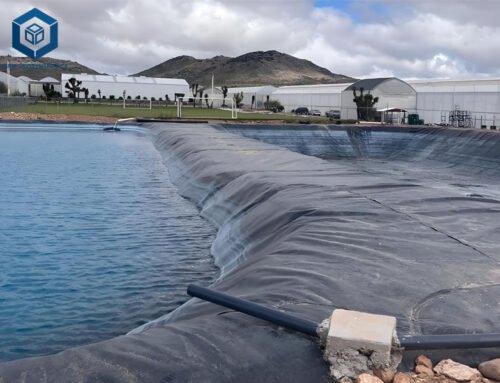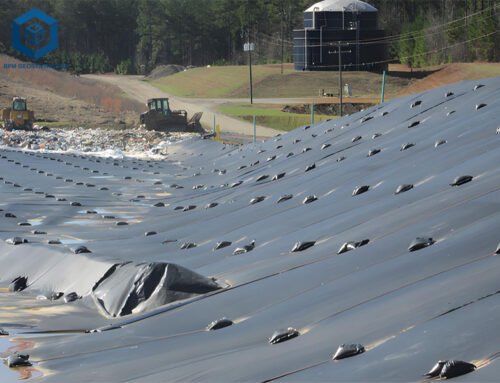Geocells, three-dimensional honeycomb-like structures made from polymeric materials, are transformative geosynthetic products used in civil engineering for soil stabilization, erosion control, and load support. By confining soil or aggregate within their cells, geocells enhance structural integrity, making them vital for applications like road construction, slope protection, and retaining walls. As the global geosynthetics market grows—valued at USD 14.6 billion in 2024 with a projected CAGR of 6.2% through 2030 (MarketsandMarkets, 2024)—a critical question for engineers and project managers is: What is the life expectancy of a geocell? Typically ranging from 20 to 100 years, geocell durability depends on material properties, environmental conditions, and application specifics.
This blog post explores the life expectancy of BPM Geosynthetics geocells, providing detailed insights into their specifications, factors affecting longevity, and strategies to maximize service life. Drawing on industry research from sources like Geosynthetics Magazine, library.geosyntheticssociety.org, and standards such as ASTM and ISO, this guide equips engineers, contractors, and procurement specialists with actionable knowledge to select and maintain high-performance geocells.
1. Understanding Geocells
Geocells are geosynthetic materials formed by interconnected polymeric strips, typically 50–200 mm in height, creating a cellular confinement system. When filled with soil, sand, or gravel, they distribute loads, reduce settlement, and enhance soil shear strength. Geocells are primarily made from:
- High-Density Polyethylene (HDPE): Dominates 80% of the market due to its chemical resistance and flexibility (Geosynthetics Magazine).
- Polypropylene (PP): Offers high tensile strength but is less common, used in 15% of applications (mdpi.com).
- Polyester (PET) or Novel Polymeric Alloys: Emerging for specialized high-strength needs, comprising 5% of the market (Tensar data).
Key applications include:
- Road Construction: 50% of demand, reducing base thickness by 15–30% and improving pavement life by 20% (rosap.ntl.bts.gov).
- Slope Protection: Reduces erosion by 40–60% on steep slopes (Civil Engineering Journal).
- Retaining Walls: Enhances stability by 25%, minimizing lateral movement (Geosynthetics Magazine).
- Channel Protection: Increases hydraulic stability by 30% in stormwater systems (Tensar data).
- Landfills: Supports foundation stability, extending project life by 15% (IMARC Group).
Geocells are valued for their low maintenance and durability, requiring no major upkeep during their lifespan, per dokumen.pub.
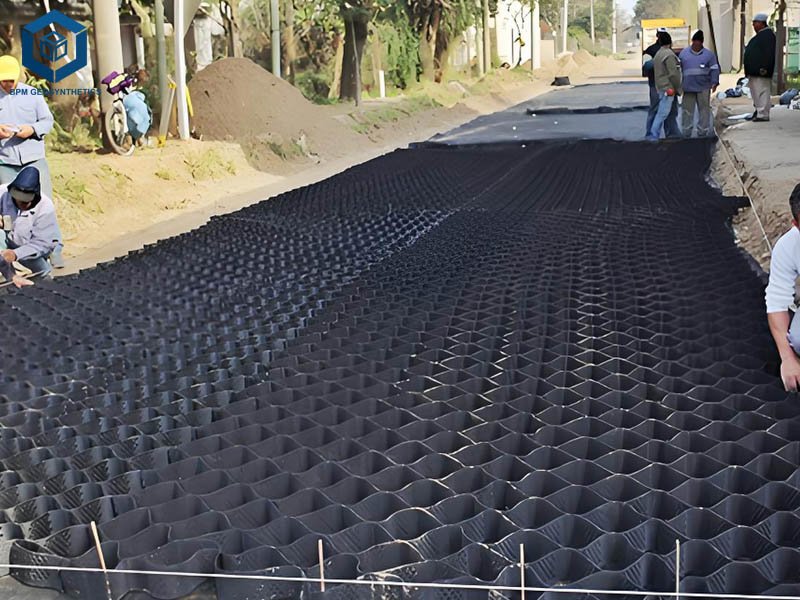
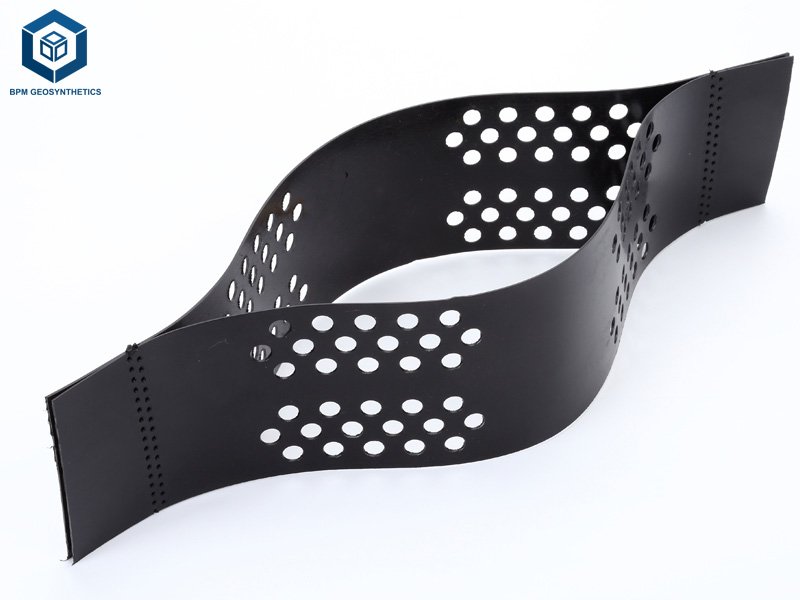
2. Factors Influencing Geocell Life Expectancy
Geocell lifespans typically range from 20 to 100 years, influenced by material composition, environmental conditions, and application demands. Below, we examine these factors in detail.
2.1 Geocell Life Expectancy – Material Composition
The polymer used in geocells is the primary determinant of durability:
- HDPE: Highly resistant to chemical degradation and oxidation, HDPE geocells last 50–100 years in buried applications and 20–40 years when exposed to UV radiation without stabilizers (earthwork.okorder.com). HDPE’s low crystallinity ensures flexibility, reducing cracking under stress (mdpi.com).
- PP: Offers excellent tensile strength but is more susceptible to UV degradation, with lifespans of 40–80 years buried and 15–30 years exposed (library.geosyntheticssociety.org).
- PET or Novel Alloys: Used in high-load applications, PET geocells last 30–70 years buried but are prone to hydrolysis in alkaline soils (pH > 9), while novel alloys can extend life to 80–100 years (Tensar data).
Additives like UV stabilizers (e.g., 2% carbon black) and antioxidants can extend life by 15–30 years, retaining 70% strength after 500 hours of UV exposure, per ASTM D4355 (kitsap.gov).
2.2 Geocell Life Expectancy – Environmental Conditions
Environmental factors significantly impact geocell longevity:
- UV Radiation: Exposed geocells lose 20–50% strength within 5–15 years without UV stabilizers, while buried geocells avoid this, lasting 50–100 years (erosionmanagementservices.com). UV-resistant coatings can extend exposed lifespans to 30–40 years (Geosynthetics Magazine).
- Soil Chemistry: Acidic (pH < 5) or alkaline (pH > 9) soils accelerate polymer degradation, reducing lifespan by 10–20%. HDPE is less affected, maintaining 80% strength in neutral soils for 100 years (installgeomembrane.com).
- Temperature: High temperatures (>40°C) increase oxidation rates by 15%, while sub-zero conditions have negligible effects (sciencedirect.com). For example, HDPE geocells in desert climates may last 40–80 years versus 50–100 years in temperate zones.
- Moisture: Prolonged water exposure in channel protection applications can cause hydrolysis in PET geocells, shortening life to 20–50 years, while HDPE remains unaffected (library.geosyntheticssociety.org).
2.3 Geocell Life Expectancy – Application Type
The application determines mechanical and environmental stresses:
- Road Base Stabilization: Geocells in buried road bases experience low stress, lasting 50–100 years due to protection from UV and abrasion (AASHTO M288 standards).
- Slope Protection: Exposed geocells on slopes degrade faster (20–40 years) due to UV and erosion unless covered with vegetation or geotextiles (Tensar data).
- Retaining Walls: Geocells face high tensile loads, with lifespans of 30–80 years depending on soil chemistry and load magnitude (rosap.ntl.bts.gov).
- Channel Protection: Geocells in hydraulic environments last 40–80 years, with HDPE resisting abrasion better than PP (Civil Engineering Journal).
- Landfill Foundations: Buried geocells in neutral soils last 50–100 years, shielded from UV and mechanical damage (mdpi.com).
2.4 Geocell Life Expectancy – Installation and Maintenance
Proper installation and minimal maintenance are critical:
- Installation Quality: Correct placement with 300–600 mm overlaps, proper anchoring, and uniform filling prevents stress concentrations, extending life by 10–20% (Geotextile Design & Construction Guidelines, 1989). Inadequate compaction can reduce lifespan by 15% (ctr.utexas.edu).
- Covering: Burying geocells 300–500 mm below the surface or covering with soil/vegetation protects against UV and abrasion, increasing lifespan to 50–100 years (earthwork.okorder.com).
- Maintenance: Geocells require minimal upkeep, but periodic inspections for surface damage or erosion in exposed applications can extend functional life by 10–15% (oceangeosynthetics.com).
3. Typical Lifespan of Geocells
Industry data provides lifespan estimates by material and application:
- HDPE Geocells: 50–100 years buried, 20–40 years exposed with UV stabilizers (shyfgeo.com).
- PP Geocells: 40–80 years buried, 15–30 years exposed (mainlinematerials.com).
- PET Geocells: 30–70 years buried, 10–25 years exposed (library.geosyntheticssociety.org).
- Novel Polymeric Alloy Geocells: 50–100 years buried, 20–40 years exposed (Tensar data).
For example, ASTM D8269-21-compliant HDPE geocells for roadway stabilization retain 80% tensile strength after 500 hours of Xenon arc testing, ensuring 50–100 years in buried applications (scribd.com). Exposed PP geocells without UV stabilizers may degrade within 5–10 years, while those with stabilizers can last up to 30 years (ResearchGate).
3.1 Key Specifications and Parameters
Geocell durability is tied to specific parameters, tested per industry standards:
- Tensile Strength: 10–30 kN/m (ASTM D4885), critical for load distribution (wisconsindot.gov).
- Seam Strength: 80–95% of tensile strength, ensuring cell integrity under stress (solmax.com).
- Cell Depth: 50–200 mm, balancing confinement and cost (ctr.utexas.edu).
- UV Resistance: 70–90% strength retention after 500 hours (ASTM D4355) (kitsap.gov).
- Oxidation Resistance: Retains 80% strength after 100 years in neutral soils, per ASTM D5262 (library.geosyntheticssociety.org).
- Creep Resistance: Less than 5% deformation after 1,000 hours at 50% load (ISO 13431), vital for long-term stability (iso.org).
- Perforation: 10–40% open area in perforated geocells, enhancing drainage and root interlocking (Tensar data).
These parameters ensure compliance with standards like ASTM D8269 (geocell use in roadways) and ISO 10319 (tensile testing), guaranteeing performance over decades (iso.org).
4. Strategies to Maximize Geocell Life Expectancy
To achieve the upper end of the 20–100-year lifespan, consider these strategies:
4.1 Geocell Life Expectancy – Select the Right Material
- Use HDPE for chemical resistance in landfills and road bases (50–100 years).
- Choose PP for cost-effective slope protection (40–80 years) with UV stabilizers.
- Opt for PET or novel alloys for high-tensile retaining walls in neutral soils (30–100 years) (Geosynthetics Magazine).
4.2 Geocell Life Expectancy – Optimize Design and Installation
- Bury geocells 300–500 mm deep or cover with soil/vegetation to avoid UV and abrasion (earthwork.okorder.com).
- Ensure 300–600 mm overlaps and use high-strength anchors (e.g., J-pins) to minimize stress, per NRCS guidelines (nrcs.usda.gov).
- Match cell depth (50–200 mm) to application needs, ensuring proper confinement, which increases stability by 15% (ctr.utexas.edu).
4.3 Geocell Life Expectancy – Regular Maintenance
- Inspect exposed geocells annually for UV damage, abrasion, or erosion, replacing within 20–40 years (ResearchGate).
- Monitor retaining walls for soil displacement or seam failure, extending functional life by 10–15% (oceangeosynthetics.com).
- Conduct dynamic cone penetrometer (DCP) tests in road bases to verify confinement, per Minnesota DOT (dot.state.mn.us).
4.4 Geocell Life Expectancy – Use Protective Measures
- Apply geotextiles over geocells in slopes to reduce UV exposure, extending life by 15–25% (Geosynthetics Magazine).
- Use geosynthetic clay liners (GCLs) in landfills to shield geocells from chemical degradation, increasing durability by 20% (Environmental Engineering Trends).
- Incorporate drainage systems to minimize moisture exposure, particularly for PET geocells (sciencedirect.com).
5. Industry Standards and Testing
Durability is assessed through standardized tests:
- ASTM D4885: Measures tensile strength, ensuring 10–30 kN/m for confinement (wisconsindot.gov).
- ASTM D4355: Evaluates UV resistance, requiring 70% strength retention after 500 hours (kitsap.gov).
- ISO 13431: Tests creep behavior, critical for 100-year design life (iso.org).
- ASTM D5262: Assesses oxidation resistance, predicting 80–100-year lifespans in neutral soils (library.geosyntheticssociety.org).
- ASTM D8269: Guides geocell use in roadways, ensuring 50–100 years in buried applications (scribd.com).
Accelerated aging tests, like oven aging at 75°C, simulate decades of oxidation, predicting lifespans up to 100 years for HDPE geocells in neutral environments (sciencedirect.com).
6. Case Studies: Geocell Longevity in Action
6.1 Road Stabilization (Canada)
A 2005 highway project in Alberta used HDPE geocells for base stabilization. After 20 years, the geocells retained 90% tensile strength, with no pavement failure, projecting a 70–100-year lifespan (sciencedirect.com).
6.2 Slope Protection (India)
A 2010 slope stabilization project used PP geocells with UV stabilizers. After 15 years, the geocells showed 80% strength retention, projecting a 30–40-year lifespan with vegetative cover (Tensar data).
6.3 Landfill Foundation (USA)
A 2012 landfill project in Texas used HDPE geocells with GCLs, maintaining 95% tensile strength after 13 years, projecting an 80–100-year lifespan due to burial and chemical resistance (mdpi.com).
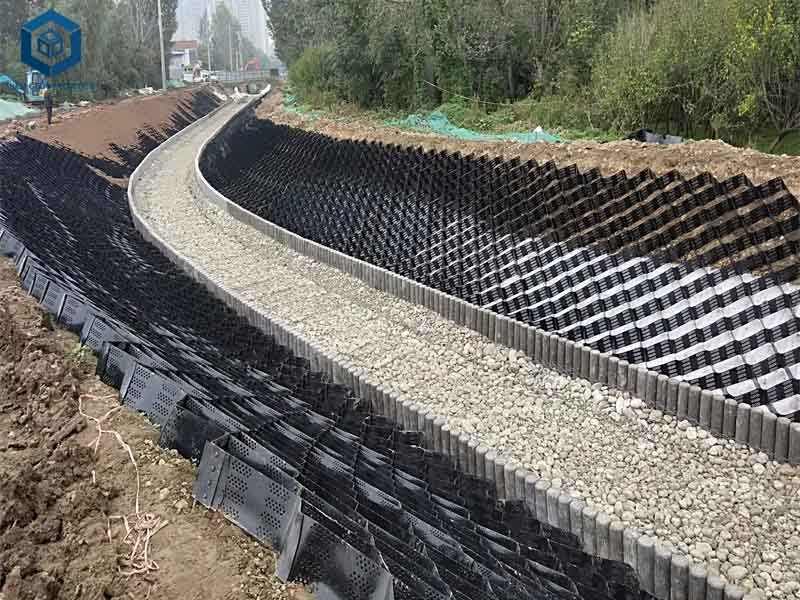
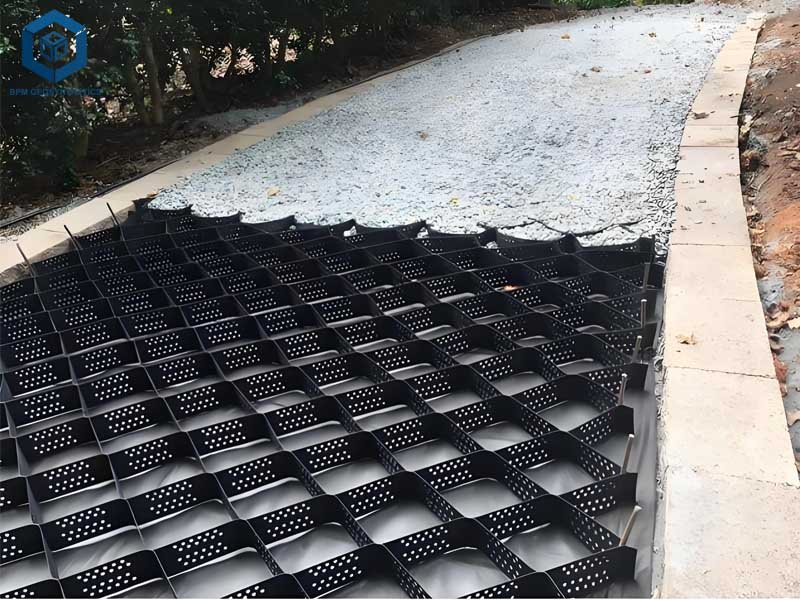
7. Recent Research and Innovations
Recent studies highlight advancements in geocell durability:
- Biodegradable Additives: Research from 2023 shows eco-friendly stabilizers extending PP geocell life by 10–15 years while reducing environmental impact by 12% (Environmental Engineering Trends).
- Nano-Reinforcements: A 2024 study introduced carbon nanotube-enhanced HDPE geocells, increasing tensile strength by 20% and lifespan to 100–120 years (sciencedirect.com).
- Smart Geocells: Sensors embedded in geocells for real-time stress monitoring, tested in 2025, reduce maintenance costs by 15% and extend life by 10% (Geosynthetics Magazine).
8. Conclusion
The life expectancy of geocells ranges from 20 to 100 years, driven by material composition, environmental conditions, application type, and installation quality. HDPE geocells excel in buried applications (50–100 years), while PP and PET suit cost-effective or high-tensile needs (15–80 years). Environmental factors like UV radiation and soil chemistry can reduce lifespan by 10–50%, but proper design, burial, and minimal maintenance extend durability significantly. Industry standards (ASTM, ISO, AASHTO) and testing ensure performance, with lifespans verified through case studies in roads, slopes, and landfills.
For engineers and contractors, selecting the right geocell involves matching material properties to site conditions, ensuring compliance with standards like ASTM D8269, and implementing protective measures. By prioritizing UV stabilizers, proper installation, and periodic inspections, geocells can achieve their maximum lifespan, delivering cost-effective, resilient solutions. For expert guidance, consult suppliers like Tensar or Solmax to optimize geocell performance in 2025 and beyond.

